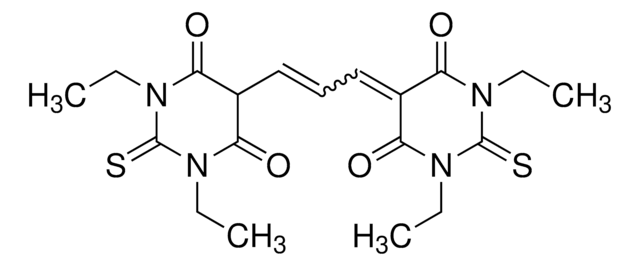D8064
4-(2-(6-(Dibutylamino)-2-naphthalenyl)ethenyl)-1-(3-sulfopropyl)pyridinium hydroxide inner salt
≥95% purity (HPLC), solid
Synonym(s):
Di-4-ANEPPS
About This Item
Recommended Products
product name
4-(2-(6-(Dibutylamino)-2-naphthalenyl)ethenyl)-1-(3-sulfopropyl)pyridinium hydroxide inner salt, ≥95% (HPLC), solid
Quality Level
Assay
≥95% (HPLC)
form
solid
mol wt
480.66
color
orange to dark red
solubility
DMF: soluble
DMSO: soluble
ethanol: soluble
ε (extinction coefficient)
≥38000 at 493-499 nm in methanol
application(s)
diagnostic assay manufacturing
hematology
histology
storage temp.
2-8°C
SMILES string
CCCCN(CCCC)c1ccc2cc(\C=C\c3cc[n+](CCCS([O-])(=O)=O)cc3)ccc2c1
InChI
1S/C28H36N2O3S/c1-3-5-17-30(18-6-4-2)28-13-12-26-22-25(10-11-27(26)23-28)9-8-24-14-19-29(20-15-24)16-7-21-34(31,32)33/h8-15,19-20,22-23H,3-7,16-18,21H2,1-2H3
InChI key
HAPJROQJVSPKCJ-UHFFFAOYSA-N
Application
Biochem/physiol Actions
Storage Class Code
11 - Combustible Solids
WGK
WGK 3
Flash Point(F)
Not applicable
Flash Point(C)
Not applicable
Personal Protective Equipment
Choose from one of the most recent versions:
Already Own This Product?
Find documentation for the products that you have recently purchased in the Document Library.
Our team of scientists has experience in all areas of research including Life Science, Material Science, Chemical Synthesis, Chromatography, Analytical and many others.
Contact Technical Service
![4-(2-[6-(Dioctylamino)-2-naphthalenyl]ethenyl)-1-(3-sulfopropyl)pyridinium inner salt ≥95% (HPLC), solid](/deepweb/assets/sigmaaldrich/product/structures/276/606/9b895cb0-f3b8-42d2-bceb-a788c0bcf884/640/9b895cb0-f3b8-42d2-bceb-a788c0bcf884.png)







